If you found this information useful, you’d love our gardening blog.
Whether you’re raising cuttings, sowing seeds or looking to protect tender plants from the worst of the British weather, our cold frames are a great addition to any garden.
If you’ve a greenhouse, cold frames are particularly useful, as they can be used for hardening off plants – allowing them to adapt from being in the protected environment of your greenhouse to changeable outdoor conditions.
From a mini garden frame right up to our 8ft x 4ft model, we have cold frames to suit any size of garden or growing need.
All our garden cold frames are manufactured in the UK using architectural-grade aluminium for greater strength and corrosion resistance. They are fitted with 3mm horticultural safety glass which, unlike the plastic sheeting used on some garden cold frames, will not bend or bow, even in the strongest winds.
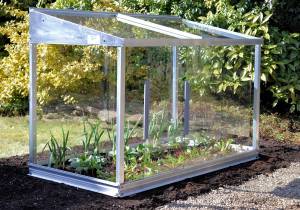
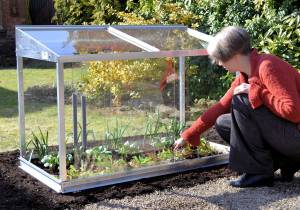
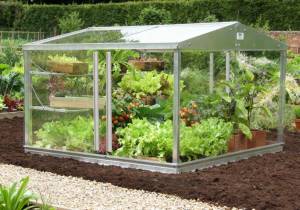
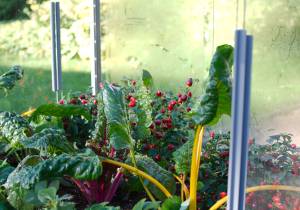
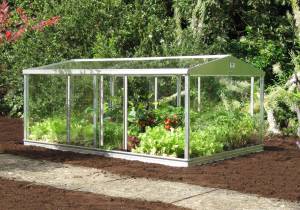
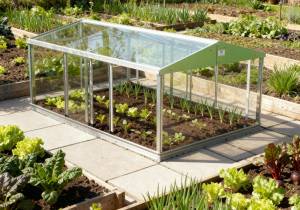
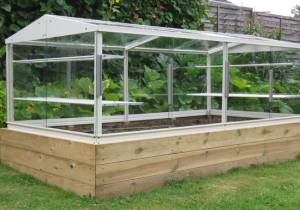
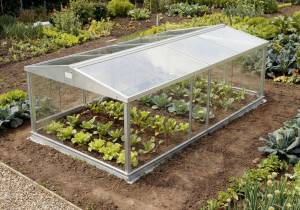
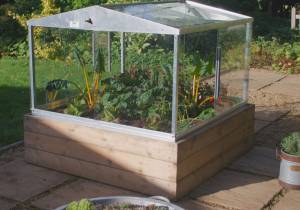

Put simply, a cold frame (sometimes called a cold frame greenhouse) is a bottomless box that is placed directly onto the soil or a raised bed.
The glass roofs of cold frames should be angled towards the sun in order to capture as much light as possible. Typically, the temperature inside a garden cold frame is between 5 and 10 degrees warmer than the outside environment.
This difference in temperature means gardeners can extend the growing season by a few valuable weeks, while protecting plants and seedlings from high winds, heavy rainfall, snow and freezing conditions.
In the spring, cold frames can also be used to house tender young plants, acting as an intermediary stage between the warm conditions of a greenhouse and the cooler environment of a garden.
If you’re a keen vegetable gardener, placing a cold frame directly onto your veg patch warms up the soil to enable early planting, at the same time providing protection from wind, rain and bugs.
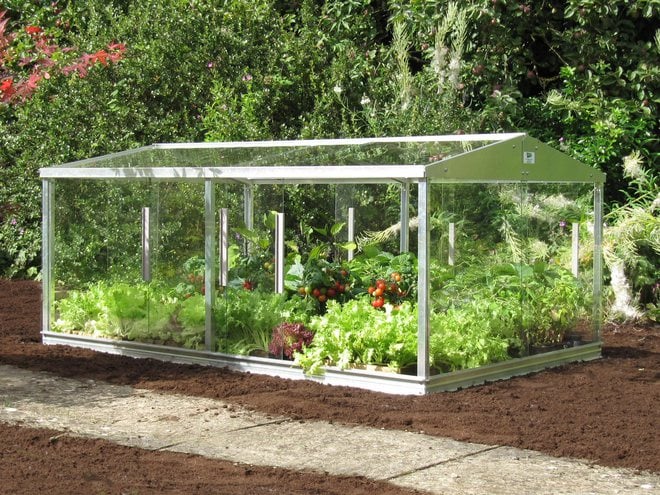
Discover the unique features of our cold frames, which distinguish them from other cold frames for sale.
Our Cold Frames are unique. Originally designed in the late 1950’s for commercial market gardeners, the Cold Frames combine easy access into the frame with superb ventilation – both the side and the roof panels all slide or can be removed for ventilation.
Unlike traditional Cold Frames, there are no lifting lids to catch the wind and the real glass (safety glass of course!) gives the frame weight to keep it on the ground – ideal for coastal and moorland locations.
Each season of the year is unique in its own way, each bringing its own challenges too. With one, or even more, of our cold frames, it’s easy to extend the growing season of your favourite plants, herbs, fruits and vegetables.

As a halfway house between the greenhouse and cooler garden conditions, cold frames are a handy place to harden off tender young plants, including those unable to withstand a wet, cold and frosty winter.
In February and March, use cold frames for an early sowing of broad beans, sweet peas and lettuce, then from April to June fill it with hardy annuals, half-hardies, plants for the veg patch and tender bedding.

Encourage a larger crop and quicker ripening by using your cold frame greenhouse to provide extra warmth for tender summer crops like tomatoes, aubergines and chillies.
Cold frames can also be used to sow biennials, such as stocks and sweet williams, for next spring. Sow into seed trays in your cold frame for added protection.

Use your cold frame at this time to protect cuttings and young plants from the cooler weather and the milder of the first frosts.
By September, they can become home to autumn-sown hardy annuals, which will happily overwinter here.
An autumn sowing of pea shoots, winter lettuce and oriental leaves in planters will give you salads right up to Christmas. In the autumn, you can also grow larger vegetables in a cold frame, including carrots and leeks.

Cold frames really do come into their own in winter. Plants that don’t like sitting in wet compost over winter, such as succulents and some herbs, can be kept dry in a garden cold frame.
If propagating plants is your thing, cold frames are a feasible alternative to a greenhouse for storing cuttings through the year. You can also overwinter young annuals and sow seeds for salad greens for a harvest in March.
While most alpines are perfectly happy in the cold of winter, they do not like the wet, which can cause them to rot. Placing your alpines in a cold frame will give them the airflow they need while protecting them from the rain.
If you found this information useful, you’d love our gardening blog.
As cold frames are passive solar collectors, and are designed to capture heat, the best place to position them is usually somewhere that offers full sunshine, but also some shelter.
In the UK and the rest of the northern hemisphere, that means the sloping top is best positioned to face south, southeast, or southwest. This allows the maximum amount of sunlight to enter the sunlight into the cold frame greenhouse during winter, when the sun travels lower in the sky.
If you’re sowing or planting directly into the ground, it will obviously be put on top of your chosen bit of soil. However, if you use your cold frames mostly for growing cuttings, it would be better to put them somewhere shady.
We’ve a wide range of cold frame accessories you could add to your cold frames, including shade covers to reduce the amount of light entering the cold frame and louvre vents to increase the level of ventilation in your garden cold frame.
We’ve also seed tray shelves and shelf covers in a variety of sizes, plus mist watering equipment and heaters. And, to reduce the amount of bending you have to do when gardening, we’ve a sustainably-sourced, three-tier timber base to raise the height of our cold frames.
As for cold frame spares, there are channel liners, handles for roof and side panels and replacement glass. Although for peace of mind, you could take out our two-year accidental glass breakage cover.
All our cold frames can be colour coated in a choice of seven attractive shades.
Cold frames are the ideal place to sow early spring seeds, either directly into the soil beneath your garden cold frame or in seed trays.
Ideally, the height of your cold frame greenhouse should be slightly taller than the height of the plants you’re growing inside when they reach maturity.
The great thing about our frames is that the glass roof sections can be removed to allow taller plants to grow out through the top.
In general, cold frames require little or no protection at night. However, if snow or frost are forecast, you could place an waterproof insulated blanket/tarp over the frame, but you would need to remove this each morning to make the most of the light.
Alternatively, you can cover your plants with a layer of horticultural fleece, which will help retain heat from the soil. Or you can fill three or four large plastic drinks bottles with very hot water and place them in the cold frame, then cover the frame with a heavy blanket.
Cold Frames are an ideal environment in which to raise cuttings, sow seeds and protect young or tender plants before they are planted in a garden. They are also a practical alternative to greenhouses if you lack the space.
They can also be used in addition to a large greenhouse – in Victorian times a kitchen garden would have a heated greenhouse and then Cold Frames to transfer the plants to as a halfway house between the greenhouse and outside, allowing the plants to harden off.
Garden cold frames will protect young plants and cuttings from the first frosts of autumn, but not the severe frosts later in the year.
From mid autumn and through winter, on cold nights a waterproof insulated blanket/tarp can be placed over the top to provide some insulation against frosts. But remember that this will reduce the amount of light and ventilation getting into the cold frame, so should be removed in the morning.
Alternatively, you can cover your plants with a layer of horticultural fleece, which will help retain heat from the soil.
The whole idea behind cold frames is that they offer ideal growing conditions by capturing the heat of the sun. So yes, ideally cold frames should be placed where they have some exposure to direct sunlight.
As the Access Cold Frame is glazed all round, aspect is not that important. If the cold frame is in full sun all day, shading can be added to keep temperatures down, or the roof panels can be removed.
The main difference between a cold frame and a greenhouse is that cold frames are not heated, relying instead on heat from the sun. Of course, with most standing just a few feet tall, they are much smaller than greenhouses.
However, just like a greenhouse, cold frames can be ventilated. This can be done by sliding open the top or sides panels, or fitting an automatic louvre system to your garden cold frame.
Cold Frames make an ideal companion to a large greenhouse, as they provide a hardening-off area for plants coming out of the greenhouse that are not quite ready for the outdoors.
Traditionally the ideal spot for a cold frame is in a position where its sloping top is facing south. This is because traditional cold frames only had glass on the roof and the sides were solid,. As cold frames work by capturing the heat of the sun, and south-facing was where it would get the most sunlight during the day. However, as the Access Cold Frame is glazed all round, aspect is not that important, but you do want a sunny location if possible.
However, not garden is ideal, so as long as the Cold Frame gets some sun, or at least plenty of ambient light, it will provide a good growing environment for the plants.
There are a number of factors that make the Access Cold Frame unique. The founder of Access has lived on the west coast of Scotland, known for its ferocious wind and rain coming off the North Atlantic. He therefore wanted a cold frame that would stand up to strong winds – so his principle was ‘nothing that lifts and nothing that hinges’.
The design he made was unique, honed from his experiences running his own market garden.
The sliding panels of the frame allow for infinitely variable ventilation, open an inch or two on sunny February days, or fully open on hot summer days. The side and roof panels can also be removed, giving even more versatility.
Access cold frames are designed to withstand storm force winds.
The very sturdy frame will not bend or buckle in the wind and the weight of the glass keeps the frame on the ground during storms.
Provided the glass has been closed up, there are no doors or lifting panels to catch the wind.
We supply our products all over the UK including to the Hebridean Islands off the Scottish coast and northern moorlands. We even supply our products into Norway.
As the frame is glazed in toughened safety glass, it will not bend under snow loads like plastic sheets will.
We recommend that the snow is cleared off the roof if it builds up – clear the roof when the snow reaches 2 – 3 ft (0.5m – 0.8m).
We hope you’re now aware of the many benefits of our aluminium cold frames, particularly as an ideal accessory to your greenhouse.
If you have any questions or need some further gardening advice about our cold frames, please contact us by calling 01788 822 301 or emailing [email protected].